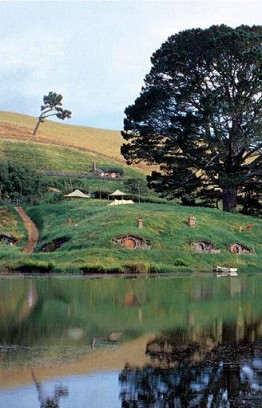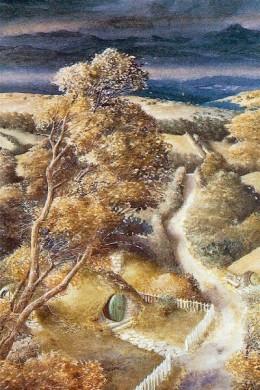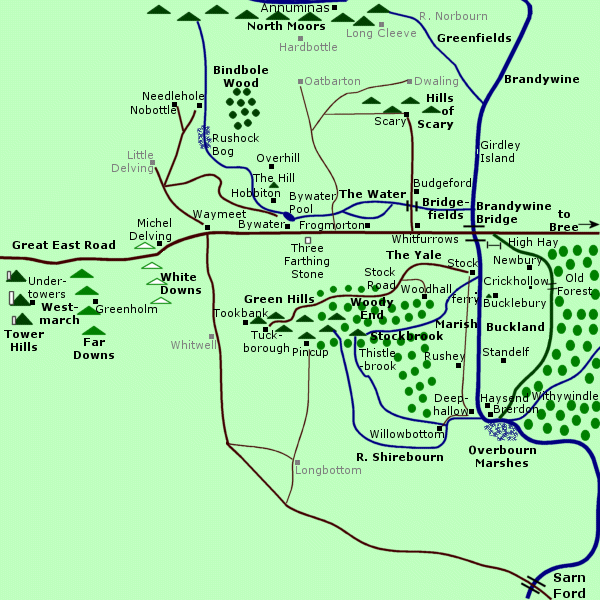

An encyclopedia of Middle-earth and Numenor

|
|
|
|
|
|
|
|
|
|
|
|
|
|
| |
|
 |

An encyclopedia of Middle-earth and Numenor |
 |

|
|
|
|
|
|
 The
Shire was a peaceful and bountiful land in Eriador
in northwestern Middle-earth. The race of people known as Hobbits lived
there, largely forgotten by the outside world until events at the end of
the Third Age brought them and their land to the attention of powers both
good and evil.
The
Shire was a peaceful and bountiful land in Eriador
in northwestern Middle-earth. The race of people known as Hobbits lived
there, largely forgotten by the outside world until events at the end of
the Third Age brought them and their land to the attention of powers both
good and evil.
Geography (see also the map below):
The Shire was 40 leagues (120 miles) across from the Far Downs on its western edge to the Brandywine River on the east. From north to south it stretched 50 leagues (150 miles) from the northern moors to the southern marshes.
The Shire was a rich, pastoral land. Much of the land was devoted to growing crops. The marshlands along the Brandywine, known as the Marish, were ideal for the cultivation of mushrooms, a Hobbit delicacy. The warm, sheltered climate of the southern part of the Shire, particularly around Longbottom, was conducive to growing pipe-weed. Barley used for brewing beer was grown in the Northfarthing and there were vineyards in the Southfarthing where grapes were grown for making wine such as the popular Old Winyards.
The Shire was divided into four quarters called Farthings: the Northfarthing, Southfarthing, Eastfarthing and Westfarthing. There were also areas named for the families that traditionally inhabited them, most notably Tookland, the home of the Tooks around Tuckborough in the Westfarthing, and Buckland, where the Brandybuck family lived on the east side of the Brandywine between the river and the Old Forest.
The landscape varied across the Shire. The Green Hill Country stretched from Tuckborough in the Westfarthing across the north end of the Southfarthing and across much of the Eastfarthing. The Hills of Scary were located in the northern part of the Eastfarthing near the Brandywine River and there were stone quarries there. The Westfarthing included the chalky White Downs as well as the Far Downs.
Several smaller rivers flowed into the Brandywine: The Water began in the north - possibly in the North Moors - and flowed through Hobbiton and Bywater; the River Shirebourn, Thistle Brook, and Stockbrook all sprang from the Green Hill Country.
Marshland included the Marish and the Overbourn Marshes along the Brandywine and Rushock Bog along the Water northwest of Hobbiton. Woodlands included Woody End in the Eastfarthing at the east end of the Green Hill Country and Bindbole Wood in the Northfarthing.
The chief township of the Shire was Michel Delving on the White Downs. Other towns and villages included Tuckborough and Hobbiton in the Westfarthing; Long Cleeve and Hardbottle in the Northfarthing; Frogmorton,Stock, and Whitfurrows in the Eastfarthing; and Longbottom in the Southfarthing. Bucklebury was the main town in Buckland.
The land that became the Shire once had farmland, vineyards, and woods belonging to the King. But the North-kingdom had fallen into disarray and the land had long been deserted.
Hobbits first came to the Shire in 1601 of the Third Age. The brothers Marcho and Blanco obtained permission from King Argeleb II to settle the lands between the Brandywine and the Far Downs. They led a large group of Hobbits from Bree west across the Brandywine and called the land Sûza, or "the Shire." The Hobbits were required to keep the roads and bridges in repair and to acknowledge the King and speed his messengers. In 1630, a number of Stoors from Dunland came to the Shire, which became the homeland of Hobbits in Middle-earth.
In 1975, according to Shire records, the Hobbits sent a company of archers to the Battle of Fornost, where the Witch-king of Angmar was defeated and driven from the north. But the North-kingdom also ended at that time, and in 1979 the Hobbits chose a Thain to hold authority in the absence of the King. Bucca of the Marish was the first Thain of the Shire. The Thain was the master of the Shire-moot and captain of the Shire-muster and the Hobbitry-in-arms. As the Shire remained at peace, the office of Thain became largely a nominal dignity.
In 2340, Gorhendad Oldbuck led his family across the Brandywine to settle in Buckland where he built Brandy Hall. He changed the family name to Brandybuck and the head of the family became known as the Master of Buckland. The office of Thain passed to the Took family. Isumbras I was the first Thain of the Took line.
The Mayor of Michel Delving was an elected official and over time became the only real government official in the Shire. The Messenger Service and the Shirriffs of the Watch fell under his authority.
Hardships occasionally befell the Hobbits of the Shire. The Great Plague in 1637 claimed many lives. In 2747, Orcs from Mount Gram invaded the Northfarthing and were defeated by a group of Hobbits led by Bandobras Took at the Battle of Greenfields. The Long Winter of 2758-59 and the famine called the Days of Dearth that followed took a great toll. Gandalf the Grey came to the aid of the Hobbits at that time and he was impressed by their courage and their pity for one another in the face of great hardship. During the Fell Winter of 2911, the Brandywine River froze and white wolves entered the Shire from the north.
 But
by and large the Hobbits of the Shire had a peaceful, prosperous, and sheltered
existence. They rarely ventured farther afield than Bree, and to many of
the peoples outside the Shire Hobbits had faded into memory and legend.
Their main claim to fame was the cultivation of pipe-weed
- which Tobold Hornblower
had first grown in the Southfarthing around 2670 - but though the art of
smoking spread among the races of Middle-earth, few were aware of its source.
But
by and large the Hobbits of the Shire had a peaceful, prosperous, and sheltered
existence. They rarely ventured farther afield than Bree, and to many of
the peoples outside the Shire Hobbits had faded into memory and legend.
Their main claim to fame was the cultivation of pipe-weed
- which Tobold Hornblower
had first grown in the Southfarthing around 2670 - but though the art of
smoking spread among the races of Middle-earth, few were aware of its source.
There were a few Hobbits of a more adventurous nature who traveled beyond the borders of the Shire into the wide world. The most notable of these was Bilbo Baggins, who embarked on the quest to reclaim the Lonely Mountain from Smaug the Dragon in 2941. It was on this journey that Bilbo found the One Ring, an event that had a profound effect on the Shire and all of Middle-earth.
By the year 3001, when Bilbo left the Shire and gave the Ring to his heir Frodo Baggins, there were increasing reports of strange people and creatures on the borders. The number of Bounders was increased, and unbeknownst to the Hobbits, the Rangers of the North were also on guard, protecting the Shire from intrusion by Outsiders.
When Frodo learned that the Ring in his possession was the Ruling Ring made by the Dark Lord Sauron, he realized that he would have to leave the Shire in order to save the land he loved.
"I should like to save the Shire, if I could - though there have been times when I thought the inhabitants too stupid and dull for words, and have felt that an earthquake or an invasion of dragons might be good for them. But I don't feel like that now. I feel that as long as the Shire lies behind, safe and comfortable, I shall find wandering more bearable: I shall know that somewhere there is a firm foothold, even if my feet cannot stand there again."Frodo left the Shire on September 26, 3018, accompanied by Sam Gamgee, Merry Brandybuck, and Pippin Took. Earlier that week on September 23, Nazgul seeking the Ring had entered the Shire, sweeping away the guard of Rangers at Sarn Ford. On September 30, they attacked the house at Crickhollow where Frodo had spent his last night in the Shire, and the Horn-call of Buckland was sounded for the first time since the Fell Winter 100 years ago. The Nazgul rode eastward out of the Shire in pursuit of the Ring-bearer.
The Fellowship of the Ring: "The Shadow of the Past," p. 71
On their quest, the four Hobbit companions frequently thought about their homeland to comfort themselves and strengthen their resolve. In the Mirror of Galadriel, Sam Gamgee saw a vision of the Shire being destroyed. His first inclination was to go home, but he remained with his master for the duration of the quest.
When the Hobbits arrived home in late 3019, they found that Sam's vision was a reality. Lotho Sackville-Baggins had been selling pipe-weed to Saruman, the traitorous Wizard. With the money he gained from the sales, Lotho expanded his business interests, tearing down trees and digging up the land to set up industries. Lotho had Mayor Will Whitfoot arrested and he had set himself up as Chief Shirriff in the New Year of 3019. At his invitation rough Men moved into the Shire and threatened the Hobbits, enforcing a number of harsh rules and restrictions imposed by the Chief.
In September of 3019, Saruman himself came to the Shire seeking vengeance for the destruction of Isengard. His lackey Grima killed Lotho, and Saruman became the new Chief. But the four Hobbit adventurers had learned much on their quest and were able to rally their fellow Hobbits to oppose the invaders. Merry Brandybuck and Pippin Took led the Hobbitry in the Battle of Bywater on November 3 and the Men were defeated and driven out of the Shire. Saruman was killed by Grima, who was in turn shot by Hobbit archers.
Sam set to work restoring the Shire to its natural bucolic state. He used the gift given to him by Galadriel, spreading the grains of soil from her orchard around the Shire and planting the mallorn seed where the Party Tree had once stood. In the spring of 3020 - 1420 by Shire Reckoning - trees sprouted and gardens grew and the harvest was bountiful. This year was known as the Great Year of Plenty and it was a time of happiness and renewal.
Frodo found himself unable to share the peace and happiness of his fellow Hobbits. He had saved the Shire and all of Middle-earth by undertaking the quest to bring the Ring to Mount Doom where it was destroyed, but in doing so he was wounded physically and burdened by terrible memories. On September 22, 3021, Frodo set out to leave the Shire behind forever and sail to the Undying Lands accompanied by Bilbo.
In the year 6 of the Fourth Age, Aragorn, King Elessar, decreed that Men were not to enter the Shire and made it a Free Land of the Northern Kingdom. Sam became Mayor of Michel Delving, Pippin became Thain, and Merry became the Master of Buckland. The holders of these three offices were made Counsellors of the North-kingdom. In the year 31, the Westmarch from the Far Downs to the Tower Hills was added to the Shire. Hobbits returned to their peaceful and prosperous state, though they were now known and respected by the outside world.
Places in grey are in approximate locations.

Third Age:
1601
Marcho and Blanco lead a group of
Hobbits from Bree to settle in the Shire with the permission of King Argeleb
II.
1630
Stoors from Dunland come to the
Shire.
1637
Many Hobbits die during the Great
Plague.
1975
The Hobbits send a company of archers
to the Battle of Fornost.
1979
Bucca of the Marish becomes the
first Thain of the Shire in the absence of a King.
2340
The office of Thain passes to the
Took family with Isumbras I, the 13th Thain. Gorhendad Oldbuck leads his
people to Buckland and changes the family name to Brandybuck. The excavation
of Brandy Hall is begun.
c. 2670
Tobold Hornblower plants the first
pipe-weed in the Southfarthing.
2683
Isengrim
II becomes Thain and starts construction of the Great
Smials.
2747
The Hobbits led by Bandobras Took
defeat the Orcs in the Battle of Greenfields.
2758-59
The Long Winter. Gandalf comes to
the aid of the Hobbits.
2790
Birth of Gerontius
Took.
2890
Birth of Bilbo Baggins.
2911
The Fell Winter. The Brandywine
freezes and White Wolves enter the Shire.
2920
Death of Gerontius, the Old Took.
2941
Bilbo Baggins leaves the Shire in
the company of Gandalf and thirteen Dwarves on the quest of the Lonely
Mountain.
2942
Bilbo returns to the Shire.
2968
Birth of Frodo Baggins.
2980
Birth of Sam Gamgee.
2982
Birth of Merry Brandybuck.
2990
Birth of Pippin Took.
3001
Bilbo Baggins leaves the Shire and
gives the Ring to Frodo. Gandalf suspects that it is One Ring, and the
Rangers increase their guard on the Shire. Strange people and creatures
are seen prowling the borders around this time.
3018
September 23: Four or five
Nazgul enter the Shire seeking Frodo Baggins.
September 26: Frodo leaves
the Shire with the One Ring accompanied by Sam, Merry & Pippin.
September 30: Frodo's house
at Crickhollow is attacked by Nazgul and the Horn-call of Buckland is sounded.
3019
January: Lotho Sackville-Baggins
declares himself Chief Shirriff shortly after the New Year. Rules and restrictions
are imposed on the Hobbits and enforced by the Chief's Men.
September 22: Saruman comes to the Shire.
October 30: Frodo and his companions return to the Shire.
November 2: The Hobbits are
rallied to rise against the Chief's Men.
November 3: The Battle of
Bywater. The Hobbits defeat the ruffians and drive them out of the Shire.
Saruman is killed by Grima.
3020 - The
Great Year of Plenty
April 6: The mallorn tree
flowers in the Party Field.
3021
September 22: The Last
Riding of the Keepers of the Rings meets in Woody End. Frodo and Bilbo
set out from the Shire for the Grey Havens
to sail to the Undying Lands.
Fourth Age:
6
King Elessar makes the Shire a Free
Land of the North Kingdom and Men are forbidden to enter it. Sam Gamgee
is elected Mayor of Michel Delving for the first of seven seven-year terms.
11
Merry Brandybuck becomes the Master
of Buckland.
13
Pippin Took becomes Thain. The Thain,
the Master of Buckland, and the Mayor of Michel Delving are made Counsellors
of the North-kingdom by King Elessar.
15
King Elessar and Queen
Arwen come to the Brandywine
Bridge and meet with the Thain, the Master, and the Mayor.
31
The Westmarch is added to the Shire
by King Elessar.
34
Fastred
of Greenholm becomes the first Warden
of Westmarch.
61
Sam Gamgee leaves the Shire to set
sail from the Grey Havens.
63
Merry Brandybuck and Pippin Took
leave the Shire for Rohan and Gondor.
The word shire means "province, district, region." In England, a shire is a county and the word appears in many place names such as Yorkshire, Hampshire, etc. The word comes from the Old English scír.
The Hobbit name for the Shire was Sûza.
Primary Sources:
The Fellowship of the Ring: "Prologue: Concerning Hobbits" and "Prologue: On the Ordering of the Shire," passim
Appendix B of The Lord of the Rings: "The Tale of Years," passim
Atlas of Middle-earth by Karen Wynn Fonstad, map of the Shire, p. 70-71
All entries are Copyright © by the Thain from former tuckborough.net. Please contact me if you are Thain or know anything about how to contact the original author.
2003-2011, The Thain's Book - thainsbook.minastirith.cz
- e-mail: thain at tuckborough.net